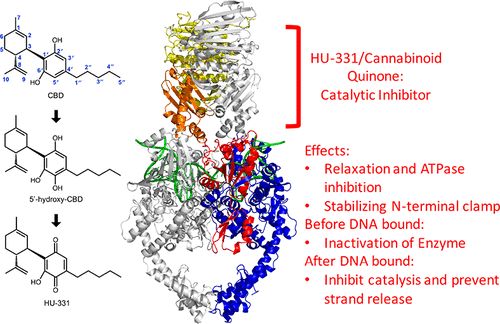当前位置:
X-MOL 学术
›
Chem. Res. Toxicol.
›
论文详情
Our official English website, www.x-mol.net, welcomes your
feedback! (Note: you will need to create a separate account there.)
HU-331 and Oxidized Cannabidiol Act as Inhibitors of Human Topoisomerase IIα and β
Chemical Research in Toxicology ( IF 3.7 ) Pub Date : 2018-01-08 00:00:00 , DOI: 10.1021/acs.chemrestox.7b00302 James T. Wilson 1 , Cole A. Fief 1 , Klarissa D. Jackson 1 , Susan L. Mercer 1 , Joseph E. Deweese 1
Chemical Research in Toxicology ( IF 3.7 ) Pub Date : 2018-01-08 00:00:00 , DOI: 10.1021/acs.chemrestox.7b00302 James T. Wilson 1 , Cole A. Fief 1 , Klarissa D. Jackson 1 , Susan L. Mercer 1 , Joseph E. Deweese 1
Affiliation

|
Topoisomerase II is a critical enzyme in replication, transcription, and the regulation of chromatin topology. Several anticancer agents target topoisomerases in order to disrupt cell growth. Cannabidiol is a major non-euphoriant, pharmacologically active component of cannabis. Previously, we examined the cannabidiol derivative HU-331 in order to characterize the mechanism of the compound against topoisomerase IIα. In this current work, we explore whether cannabidiol (CBD) impacts topoisomerase II activity, and we additionally examine the activity of these compounds against topoisomerase IIβ. CBD does not appear to strongly inhibit DNA relaxation and is not a poison of topoisomerase II DNA cleavage. However, oxidation of CBD allows this compound to inhibit DNA relaxation by topoisomerase IIα and β without poisoning DNA cleavage. Additionally, we found that oxidized CBD, similar to HU-331, inhibits ATP hydrolysis and can result in inactivation of topoisomerase IIα and β. We also determined that oxidized CBD and HU-331 are both able to stabilize the N-terminal clamp of topoisomerase II. Taken together, we conclude that while CBD does not have significant activity against topoisomerase II, both oxidized CBD and HU-331 are active against both isoforms of topoisomerase II. We hypothesize that oxidized CBD and HU-331 act against the enzyme through interaction with the N-terminal ATPase domain. According to the model we propose, topoisomerase II inactivation may result from a decrease in the ability of the enzyme to bind to DNA when the compound is bound to the N-terminus.
中文翻译:

HU-331和氧化的大麻二酚充当人类拓扑异构酶IIα和β的抑制剂
拓扑异构酶II是复制,转录和染色质拓扑结构调控中的关键酶。几种抗癌剂靶向拓扑异构酶,以破坏细胞生长。大麻二酚是大麻的主要非欣快性,药理活性成分。以前,我们研究了大麻二酚衍生物HU-331,以表征该化合物对抗拓扑异构酶IIα的机制。在当前的工作中,我们探讨了大麻二酚(CBD)是否会影响拓扑异构酶II的活性,并且我们还将检查这些化合物对拓扑异构酶IIβ的活性。CBD似乎没有强烈抑制DNA松弛,并且不是拓扑异构酶II DNA裂解的毒药。然而,CBD的氧化使该化合物能够抑制拓扑异构酶IIα和β抑制DNA松弛,而不会破坏DNA裂解。此外,我们发现,与HU-331相似,氧化的CBD抑制ATP水解,并可能导致拓扑异构酶IIα和β失活。我们还确定,氧化的CBD和HU-331都能够稳定拓扑异构酶II的N末端钳位。两者合计,我们得出结论,尽管CBD对拓扑异构酶II没有明显的活性,但氧化的CBD和HU-331对拓扑异构酶II的两种同工型均具有活性。我们假设氧化的CBD和HU-331通过与N末端ATPase结构域的相互作用而对该酶起作用。根据我们提出的模型,拓扑异构酶II失活可能是由于当化合物与N末端结合时酶与DNA结合的能力降低所致。抑制ATP水解并可能导致拓扑异构酶IIα和β失活。我们还确定,氧化的CBD和HU-331都能够稳定拓扑异构酶II的N末端钳位。两者合计,我们得出结论,尽管CBD对拓扑异构酶II没有明显的活性,但氧化的CBD和HU-331对拓扑异构酶II的两种同工型均具有活性。我们假设氧化的CBD和HU-331通过与N末端ATPase结构域的相互作用而对该酶起作用。根据我们提出的模型,拓扑异构酶II失活可能是由于当化合物与N末端结合时酶与DNA结合的能力降低所致。抑制ATP水解并可能导致拓扑异构酶IIα和β失活。我们还确定,氧化的CBD和HU-331都能够稳定拓扑异构酶II的N末端钳位。两者合计,我们得出结论,尽管CBD对拓扑异构酶II没有明显的活性,但氧化的CBD和HU-331对拓扑异构酶II的两种同工型均具有活性。我们假设氧化的CBD和HU-331通过与N末端ATPase结构域的相互作用而对该酶起作用。根据我们提出的模型,拓扑异构酶II失活可能是由于当化合物与N末端结合时酶与DNA结合的能力降低所致。我们得出的结论是,尽管CBD对拓扑异构酶II没有明显的活性,但是氧化的CBD和HU-331对拓扑异构酶II的两种同工型均具有活性。我们假设氧化的CBD和HU-331通过与N末端ATPase结构域的相互作用而对该酶起作用。根据我们提出的模型,拓扑异构酶II失活可能是由于当化合物与N末端结合时酶与DNA结合的能力降低所致。我们得出的结论是,尽管CBD对拓扑异构酶II没有明显的活性,但是氧化的CBD和HU-331对拓扑异构酶II的两种同工型均具有活性。我们假设氧化的CBD和HU-331通过与N末端ATPase结构域的相互作用而对该酶起作用。根据我们提出的模型,拓扑异构酶II失活可能是由于当化合物与N末端结合时酶与DNA结合的能力降低所致。
更新日期:2018-01-08
中文翻译:

HU-331和氧化的大麻二酚充当人类拓扑异构酶IIα和β的抑制剂
拓扑异构酶II是复制,转录和染色质拓扑结构调控中的关键酶。几种抗癌剂靶向拓扑异构酶,以破坏细胞生长。大麻二酚是大麻的主要非欣快性,药理活性成分。以前,我们研究了大麻二酚衍生物HU-331,以表征该化合物对抗拓扑异构酶IIα的机制。在当前的工作中,我们探讨了大麻二酚(CBD)是否会影响拓扑异构酶II的活性,并且我们还将检查这些化合物对拓扑异构酶IIβ的活性。CBD似乎没有强烈抑制DNA松弛,并且不是拓扑异构酶II DNA裂解的毒药。然而,CBD的氧化使该化合物能够抑制拓扑异构酶IIα和β抑制DNA松弛,而不会破坏DNA裂解。此外,我们发现,与HU-331相似,氧化的CBD抑制ATP水解,并可能导致拓扑异构酶IIα和β失活。我们还确定,氧化的CBD和HU-331都能够稳定拓扑异构酶II的N末端钳位。两者合计,我们得出结论,尽管CBD对拓扑异构酶II没有明显的活性,但氧化的CBD和HU-331对拓扑异构酶II的两种同工型均具有活性。我们假设氧化的CBD和HU-331通过与N末端ATPase结构域的相互作用而对该酶起作用。根据我们提出的模型,拓扑异构酶II失活可能是由于当化合物与N末端结合时酶与DNA结合的能力降低所致。抑制ATP水解并可能导致拓扑异构酶IIα和β失活。我们还确定,氧化的CBD和HU-331都能够稳定拓扑异构酶II的N末端钳位。两者合计,我们得出结论,尽管CBD对拓扑异构酶II没有明显的活性,但氧化的CBD和HU-331对拓扑异构酶II的两种同工型均具有活性。我们假设氧化的CBD和HU-331通过与N末端ATPase结构域的相互作用而对该酶起作用。根据我们提出的模型,拓扑异构酶II失活可能是由于当化合物与N末端结合时酶与DNA结合的能力降低所致。抑制ATP水解并可能导致拓扑异构酶IIα和β失活。我们还确定,氧化的CBD和HU-331都能够稳定拓扑异构酶II的N末端钳位。两者合计,我们得出结论,尽管CBD对拓扑异构酶II没有明显的活性,但氧化的CBD和HU-331对拓扑异构酶II的两种同工型均具有活性。我们假设氧化的CBD和HU-331通过与N末端ATPase结构域的相互作用而对该酶起作用。根据我们提出的模型,拓扑异构酶II失活可能是由于当化合物与N末端结合时酶与DNA结合的能力降低所致。我们得出的结论是,尽管CBD对拓扑异构酶II没有明显的活性,但是氧化的CBD和HU-331对拓扑异构酶II的两种同工型均具有活性。我们假设氧化的CBD和HU-331通过与N末端ATPase结构域的相互作用而对该酶起作用。根据我们提出的模型,拓扑异构酶II失活可能是由于当化合物与N末端结合时酶与DNA结合的能力降低所致。我们得出的结论是,尽管CBD对拓扑异构酶II没有明显的活性,但是氧化的CBD和HU-331对拓扑异构酶II的两种同工型均具有活性。我们假设氧化的CBD和HU-331通过与N末端ATPase结构域的相互作用而对该酶起作用。根据我们提出的模型,拓扑异构酶II失活可能是由于当化合物与N末端结合时酶与DNA结合的能力降低所致。











































 京公网安备 11010802027423号
京公网安备 11010802027423号